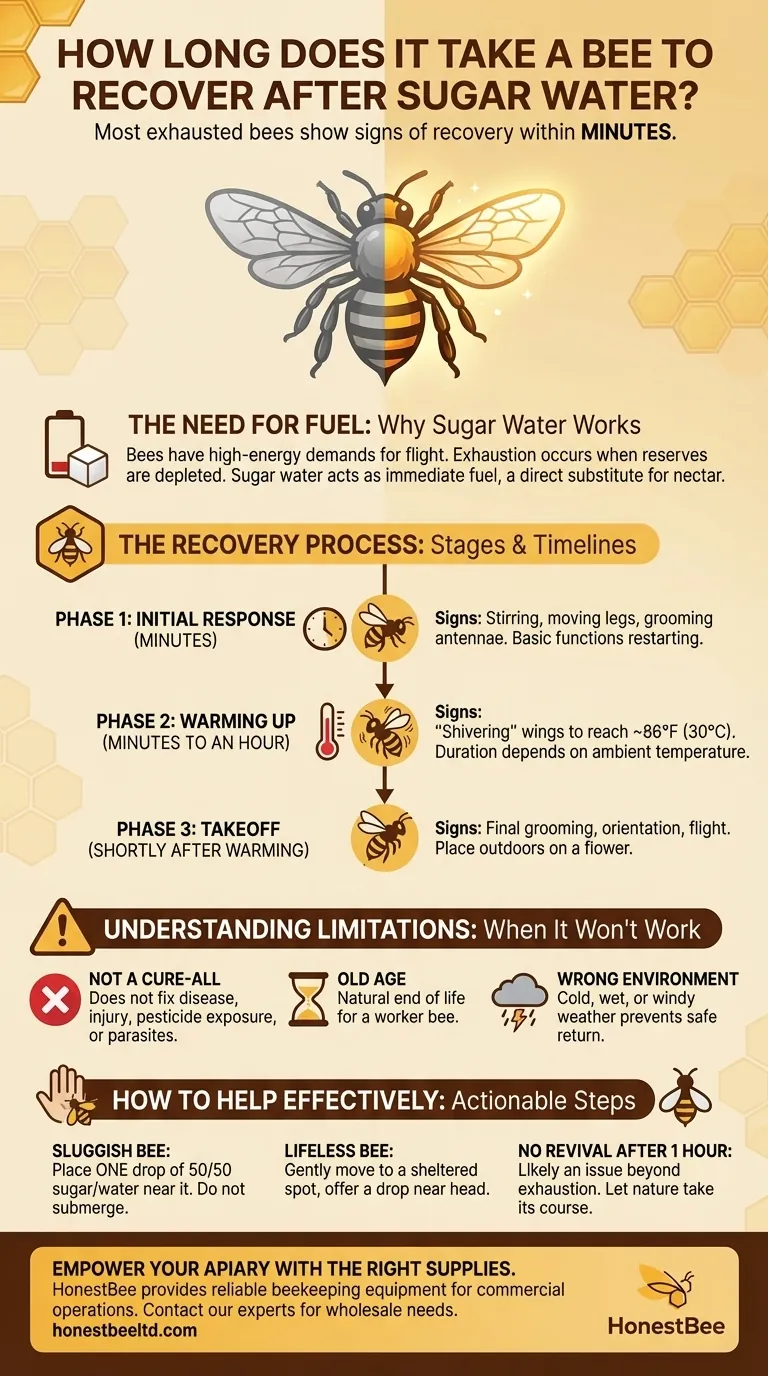In most cases, an exhausted bee will show signs of recovery within minutes of consuming sugar water. Even a bee that appears lifeless can revive surprisingly quickly once it has access to this simple energy source, often beginning to move its legs or antennae in a very short time.
A 50/50 solution of white sugar and water is an emergency fuel for an exhausted bee, not a cure-all. Understanding its purpose is key to knowing when and how to help effectively.

Why Sugar Water Revives an Exhausted Bee
To understand the recovery process, it's helpful to first understand why a bee might need help. Bees operate on an incredibly high-energy budget, requiring constant fuel to power their flight muscles.
The Bee's Energy Demands
A bee's flight is one of the most energy-intensive activities in the animal kingdom. This requires a near-constant intake of nectar, which is their natural, high-sugar fuel source.
A State of Exhaustion
Sometimes, a bee can be caught out by a sudden change in weather, fly too far from a nectar source, or simply be unable to find enough food. When its energy reserves are completely depleted, it becomes grounded and unable to fly.
Sugar as an Immediate Fuel
The sugar water you provide acts as a direct substitute for nectar. It delivers a rapid dose of simple carbohydrates that the bee's body can immediately convert into the energy needed to warm up and power its flight muscles.
The Recovery Process: What to Expect
Recovery happens in stages, and observing them helps you know if your intervention is working.
Phase 1: The Initial Response (Minutes)
Within minutes of drinking, you should see the first signs of life. The bee might begin to stir, move its legs, or start grooming its antennae. This indicates its basic metabolic functions are restarting.
Phase 2: Warming Up for Flight
After the initial energy boost, the bee must warm its thoracic muscles to the temperature required for flight (around 86°F or 30°C). It does this by "shivering" or vibrating its wings, which can take some time. This phase can last anywhere from a few minutes to nearly an hour, depending on the ambient temperature.
Phase 3: Preparing for Takeoff
Once warm, the bee will typically perform some final grooming, orient itself, and then take flight. If you have the bee indoors, place it on a flower or near an open window to help it on its way.
Understanding the Limitations
While offering sugar water is a powerful act of kindness, it is not a universal remedy. It's critical to recognize when it will not work.
Not a Cure for Disease or Injury
Sugar water only addresses exhaustion. It cannot cure a bee suffering from pesticide exposure, a viral or fungal infection, parasite infestation (like the Varroa mite), or physical injuries like a torn wing.
The Factor of Old Age
A worker bee's lifespan during the busy summer is only a few weeks. A bee found crawling on the ground may simply be at the natural end of its life, and no amount of sugar water will change that outcome.
The Wrong Environment
If the weather is cold, wet, or windy, a revived bee may be unable to fly safely back to its hive. It needs a window of clear, calm weather to make a successful return.
How to Help Effectively
Your goal is to provide temporary support, not to make the bee a long-term patient.
- If you find a sluggish but moving bee: Place a single drop of 50/50 white sugar and water solution on a surface in front of it. Do not submerge it.
- If the bee appears lifeless: Gently use a leaf or piece of paper to move it to a safe, sheltered spot away from foot traffic and offer a drop of sugar water near its head.
- If the bee has not revived after an hour: It is likely suffering from an issue beyond simple exhaustion. At this point, the most compassionate action is to let nature take its course.
By providing this simple support, you give a vital pollinator the best possible chance to continue its important work.
Summary Table:
| Recovery Phase | Typical Duration | Key Signs of Progress |
|---|---|---|
| Initial Response | A few minutes | Bee begins to stir, move legs, or groom antennae. |
| Warming Up | Several minutes to an hour | Bee "shivers" wings to heat flight muscles to 86°F (30°C). |
| Takeoff | Shortly after warming | Bee grooms itself, orients, and flies away. |
Empower Your Apiary with the Right Supplies
Just as sugar water provides essential fuel for an exhausted bee, having reliable, high-quality equipment is fundamental to the health and productivity of your entire operation. HONESTBEE supplies beekeeping supplies and equipment to commercial apiaries and beekeeping equipment distributors through wholesale-focused operations.
We help you build a resilient and thriving business with durable, efficient tools. Contact our experts today to discuss your wholesale needs and keep your apiary buzzing.
Visual Guide

Related Products
- Classic Boardman Entrance Bee Feeder Hive Front Feeding Solution
- HONESTBEE Entrance Bee Feeder Professional Hive Nutrition Solution for Beekeeping
- HONESTBEE Round Hive Top Bee Feeder for Syrup
- Rapid Bee Feeder White Plastic 2L Round Top Feeder for 8 or 10-Frame Bee Hives
- HONESTBEE Entrance Bee Feeder Efficient Hive Front Liquid Feeding Solution for Beekeeping
People Also Ask
- What types of bee feeders are available for beginners? Start with the Simple Entrance Feeder
- How to make an entrance feeder for bees? A DIY Guide for Safe & Effective Feeding
- What is the best feeder for bees? Choose the Right Feeder for Your Hive's Success
- How can a Boardman Feeder be used to provide water to bees? Avoid These Critical Risks to Your Hive
- How is the mesh ladder and barrier installed in the feeder box? A Step-by-Step Guide to Prevent Bee Drowning



















